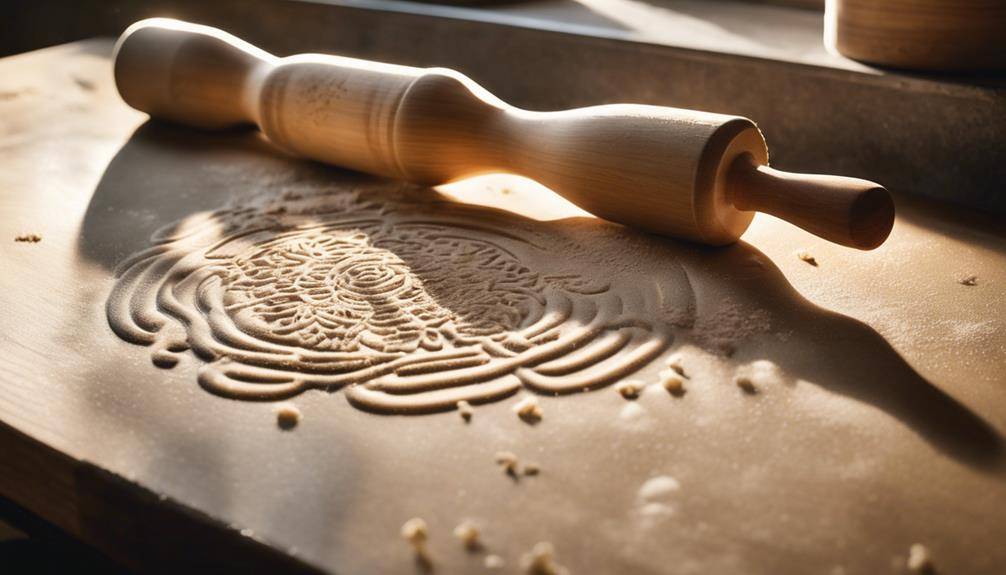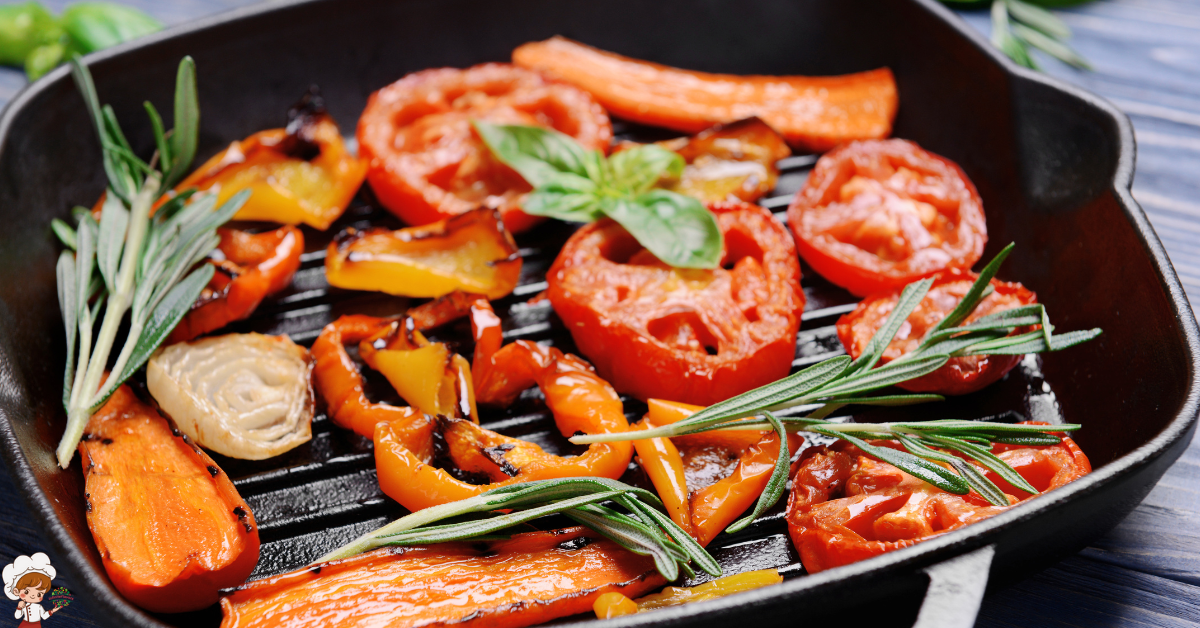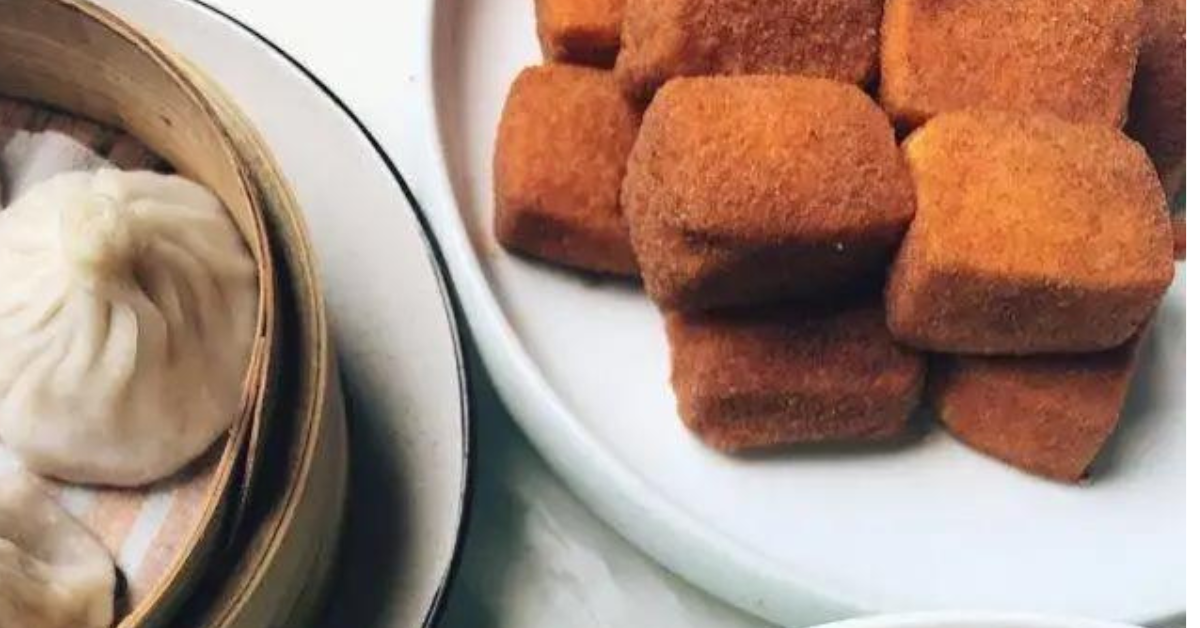Amazing Rolling Pins With Measurement Guides

If you’re looking to up your baking game, Rolling Pins With Measurement Guides are your best friend. They guarantee you achieve consistent dough thickness, boosting your baking precision. These pins come in various materials like wood, silicone, and marble, so you can choose one that fits your style. The built-in measurements eliminate guesswork, saving you time and reducing mistakes. Brands like Joseph Joseph and OXO offer excellent options with clear markings for easy use. With these tools, you’ll craft perfect pies, cookies, and pasta every time. Discover how these versatile rolling pins can enhance your kitchen skills.
Benefits of Measurement Guides
Measurement guides on rolling pins offer a straightforward way to achieve consistent dough thickness, making your baking experience smoother and more enjoyable. When you use a rolling pin with measurement guides, you eliminate the guesswork involved in achieving the perfect thickness for your dough. This time-saving convenience allows you to focus more on the creative aspects of baking rather than fretting over whether your dough is too thick or too thin.
With these guides, you can roll out dough to the exact specifications needed for different recipes, ensuring that your cookies, pie crusts, and pastries all bake evenly. This baking consistency not only improves the appearance of your baked goods but also enhances their taste and texture. Even if you’re a novice baker, having the right measurements at your fingertips can boost your confidence. You’ll find that you can replicate your favorite recipes with greater ease, leading to fewer mistakes and less wasted ingredients.
Moreover, using a rolling pin with measurement guides can help streamline your baking process. When you’re preparing multiple batches of dough, being able to roll to the same thickness every time speeds up your workflow. You won’t need to keep checking with a ruler or your eyes, which can sometimes lead to inaccuracies.
Types of Rolling Pins
When it comes to rolling pins, you’ll find various types designed to suit different baking needs and preferences. One of the most popular choices is the classic wooden option. These rolling pins are sturdy, durable, and provide excellent control while rolling out dough. They come in different styles, including the traditional tapered design and the more modern straight style. Wooden pins are great for a variety of doughs, from pie crusts to cookies, and they add a touch of warmth to your kitchen.
On the other hand, you might prefer silicone varieties, especially if you’re looking for something non-stick and easy to clean. Silicone rolling pins are lightweight and flexible, making them ideal for delicate doughs like puff pastry or fondant. Plus, they’re often dishwasher-safe, which simplifies cleanup. Some silicone options even come with measurement guides printed on the surface, allowing you to roll your dough to the perfect thickness without the need for additional tools.
If you’re after versatility, consider a hybrid rolling pin that combines materials, like a wooden core with a silicone exterior. This type offers the best of both worlds, giving you the control of wood and the non-stick properties of silicone. No matter which type you choose, each rolling pin has its own unique benefits, so you can find the one that perfectly suits your baking style.
Key Features to Consider
When choosing a rolling pin with measurement guides, you’ll want to pay attention to a few key features. Measurement accuracy is essential for consistent baking results, while the material’s durability affects how long your rolling pin will last. Don’t forget about handle comfort, as a well-designed handle can make a big difference during longer baking sessions.
Measurement Accuracy Importance
Accurate measurements are essential in baking, as even slight deviations can affect the texture and flavor of your finished product. When you’re using a rolling pin with measurement guides, you’re ensuring measurement precision that leads to baking consistency. This means your dough will roll out to the exact thickness you need, whether you’re making cookies, pie crusts, or bread.
Having clear measurement markings on your rolling pin allows you to easily track your progress, reducing the guesswork involved in baking. This helps you achieve uniform thickness across your dough, which is vital for even baking. If your dough isn’t consistent, you might end up with unevenly baked treats—some parts could be overcooked while others remain undercooked.
Moreover, measurement precision can simplify your baking process. With a reliable guide, you won’t have to keep pulling out your ruler or tape measure, allowing you to focus more on the fun aspects of baking. Whether you’re a novice baker or a seasoned pro, investing in a rolling pin with measurement guides can elevate your baking game and enhance your culinary creations. Enjoy the benefits of accurate measurements and see the difference in your results!
Material Durability Factors
Choosing the right material for your rolling pin can greatly impact its durability and performance in the kitchen. Different materials offer varying levels of wear resistance and longevity, so it’s crucial to reflect on what suits your baking needs best.
Wooden rolling pins, for example, are classic choices known for their warmth and ease of use. However, make sure to select high-quality hardwood, as it typically features better material composition and can resist wear better than softer woods. On the other hand, marble or stone rolling pins are incredibly durable and provide excellent weight for flattening dough, but they can chip or crack if mishandled.
Stainless steel is another great option, known for its resistance to wear and easy maintenance. It won’t absorb odors or stains, making it a hygienic choice.
Regardless of the material you choose, always contemplate how it will withstand the rigors of frequent use. Investing in a rolling pin with high wear resistance will save you money in the long run, ensuring it remains a reliable kitchen tool for years to come.
Handle Comfort Design
After selecting a durable material for your rolling pin, it’s important to focus on the handle comfort design. A well-designed handle can make all the difference during baking sessions, especially when rolling out dough for extended periods. Look for an ergonomic grip that fits comfortably in your hand, reducing fatigue and allowing for better control.
When considering handle materials, think about options like wood, silicone, or stainless steel. Each material offers unique benefits; for instance, wooden handles often provide a warm, natural feel, while silicone can enhance grip and comfort. Make sure the handle is thick enough to hold comfortably without straining your fingers, yet not so bulky that it affects your dexterity.
Test different designs to find what feels best for you. A rolling pin with a tapered handle or one that’s contoured to fit your grip can greatly improve your experience. Remember, the right handle comfort design can transform your baking routine into a more enjoyable and efficient process. So, prioritize comfort and functionality when choosing your rolling pin, and you’ll find yourself rolling out dough with ease.
Top Brands and Models
When you’re looking for the perfect rolling pin with measurement guides, knowing the top brands can make all the difference. Some brands have built a reputation for quality and precision, while others boast innovative measurement models that simplify your baking. Let’s explore which options stand out and why they might be the right fit for your kitchen.
Popular Rolling Pin Brands
In recent years, several rolling pin brands have gained popularity among home bakers and professionals alike, each offering unique features and styles. When you’re on the hunt for the perfect rolling pin, you’ll notice brand comparisons can help narrow down your options.
One standout is the Joseph Joseph adjustable rolling pin, known for its innovative design that includes removable rings for precise thickness. Users often praise its versatility, making it a favorite for various baking projects. Another popular choice is the OXO Good Grips rolling pin, which boasts a comfortable grip and a sturdy construction. Its well-rounded design appeals to many bakers, enhancing user preferences for durability and ease of use.
If you’re looking for a more traditional option, the French-style tapered rolling pin from the likes of Tapered Rolling Pin Company is highly regarded. It allows for excellent control and maneuverability. Each brand brings something different to the table, catering to various baking needs and styles. By understanding these popular brands, you can make an informed decision that aligns with your baking habits.
Best Measurement Models
Selecting the right rolling pin with measurement guides can greatly enhance your baking precision. When you choose a model that includes built-in measurements, you’re setting yourself up for success. Brands like Joseph Joseph, OXO, and Pampered Chef have established themselves as top contenders in this space.
Joseph Joseph’s adjustable rolling pin stands out with removable rings that allow you to easily control dough thickness, ensuring consistent results every time. With measurement techniques integrated into the design, you can roll out dough to exact specifications.
OXO’s rolling pin features engraved measurement markings along the barrel, helping you gauge the size of your dough without second-guessing. This straightforward approach lets you focus on your recipe without the hassle of measuring afterward.
Pampered Chef offers a versatile option with a lightweight design and a clear guide for thickness. It’s perfect for those who appreciate practicality and ease in the kitchen.
Each of these models helps you achieve the right dough thickness effortlessly, so you can tackle everything from cookies to pastries with confidence. Investing in one of these rolling pins means you’ll never have to worry about uneven dough again.
How to Use Effectively
Using a rolling pin with measurement guides can transform your baking experience, making it easier to achieve consistent thickness for dough. To get started, lay your dough on a clean, floured surface. Before rolling, check the measurement guides on your rolling pin to determine the desired dough thickness. Whether you’re making cookies, pie crusts, or bread, the guides guarantee you won’t roll it too thick or too thin.
When you begin rolling, apply even pressure and use smooth, controlled movements. It’s crucial to roll from the center outwards to maintain an even shape. If you’re aiming for a specific thickness, focus on the measurement markers to help you gauge your progress. If your dough sticks, don’t hesitate to dust it lightly with flour; this keeps it from adhering to the surface or the pin.
Incorporating these techniques for precision will not only improve your dough thickness but also enhance your overall baking results. If you’re working with different types of dough, like pastry or pizza, remember that each may require slight adjustments in pressure or technique.
After rolling, take a moment to inspect your dough. Use the measurement guides to verify that it meets your required specifications before cutting or shaping. With practice, you’ll find that your rolling pin with measurement guides becomes an indispensable tool in your kitchen, helping you achieve professional-level results with every bake.
Cleaning and Maintenance Tips
Keeping your rolling pin with measurement guides clean and well-maintained is essential for its longevity and your baking success. Regular cleaning prevents the buildup of flour and dough residues, which can affect the accuracy of your measurements and the quality of your baked goods. After each use, wipe down your rolling pin with a damp cloth to remove any leftover particles. For deeper cleaning, use a mixture of warm water and mild soap. Avoid soaking your rolling pin, especially if it’s made of wood, as excessive moisture can lead to warping or cracking.
When it comes to cleaning techniques, a soft sponge or cloth is best. Steer clear of abrasive cleaners that could scratch the surface or damage your measurement guides. If you notice any stubborn stains, a paste made of baking soda and water can work wonders—just apply it gently and rinse thoroughly afterward.
As for maintenance frequency, make it a habit to inspect your rolling pin regularly. Look for any signs of wear, such as cracks or rough spots. If you spot any issues, consider sanding down rough areas lightly with fine-grit sandpaper. Additionally, applying food-safe mineral oil periodically can help keep the wood conditioned and prevent drying out.
Common Mistakes to Avoid
Many bakers unknowingly make mistakes when using rolling pins with measurement guides, which can hinder their baking results. One common error is not paying attention to dough consistency. If your dough is too sticky or too dry, the measurement guides won’t help you achieve the desired thickness. Always guarantee your dough is well-prepared before rolling by following proper baking techniques.
Another mistake is rolling out the dough too quickly. Rushing can lead to uneven thickness, making it challenging to achieve consistent baking results. Take your time and roll the dough gradually, allowing it to stretch evenly. Remember to check your measurements frequently, as dough can easily become thinner in some areas than others.
You might also forget to flour your surface and rolling pin adequately. Insufficient flour can cause the dough to stick, making it difficult to use the measurement guides effectively. Lightly dusting both your work surface and rolling pin can prevent this issue and help maintain the dough’s integrity during the rolling process.
Lastly, don’t overlook the importance of checking your measurements. It’s easy to misread the guide, especially when you’re focused on rolling. Take a moment to pause and verify that you’re achieving the right thickness, guaranteeing you get the best results for your baked goods. By avoiding these common mistakes, you’ll improve your baking techniques and enjoy more successful baking adventures.
Creative Uses Beyond Baking
Rolling pins with measurement guides aren’t just for dough; they can be surprisingly versatile tools in your kitchen. When you think outside the box, you’ll find they’re perfect for crafting various culinary delights. If you’re making homemade pasta, use your rolling pin to achieve that perfect thickness. The guides help guarantee consistency, so your pasta cooks evenly.
You can also roll out pizza dough effortlessly. The measurements allow you to create a perfectly sized crust every time. Similarly, when preparing pastry sheets for savory tarts or pie crusts, you can achieve the right dimensions without any guesswork. It’s a real game-changer!
Fondant decorating becomes a breeze with a rolling pin that has measurement guides. Whether you’re smoothing out fondant for cakes or creating intricate cookie designs, the precise measurements guarantee your decorations are uniform and professional-looking.
But don’t limit your rolling pin use to just baking. Get creative with crafting projects! Use it to roll out clay for DIY ornaments or other fun art projects. The measurement guides can help you achieve the right thickness for any project.
In essence, a rolling pin with measurement guides is a multifunctional tool. From rolling out pie crusts and pastry sheets to crafting homemade pasta and engaging in fun craft projects, this kitchen essential can do it all. So, the next time you reach for your rolling pin, think beyond baking and explore its endless creative possibilities!
Customer Reviews and Ratings
Customers rave about rolling pins with measurement guides, highlighting their ease of use and versatility. Many users appreciate how these pins simplify the baking process, allowing for consistent dough thickness every time. You’ll find that customer satisfaction rates are high, as folks love the clear measurements printed on the surface, which help eliminate guesswork when rolling out dough for cookies, pies, or even pasta.
User experiences vary, but a common theme is the convenience these rolling pins bring to the kitchen. For instance, many bakers mention that they no longer need to rely on calipers or rulers, making the process more enjoyable and less stressful. If you’re someone who bakes regularly, you’ll likely appreciate how much time and hassle this tool can save you.
Additionally, users often highlight the durability and quality of materials used in these rolling pins. Whether it’s wood, silicone, or marble, they note how well these pins hold up over time, making them a worthwhile investment. Many reviews also emphasize how easy they are to clean, which is always a bonus after a long baking session.
Frequently Asked Questions: Rolling Pins With Measurement Guides
Are Measurement Guides on Rolling Pins Removable or Permanent?
When considering measurement guides, you’ll find some have removable features that allow flexibility, while others sport permanent markings. It is crucial to choose based on your cooking style and how often you need adjustments.
Can Measurement Guides Be Used for Dough Thickness in Different Recipes?
Yes, you can use measurement guides for dough thickness across different recipes. Just remember, dough consistency may vary, so adjust accordingly based on recipe variations to achieve the desired results each time you bake.
Do Measurement Guides Affect the Rolling Pin’s Overall Weight and Balance?
Measurement guides can change a rolling pin’s overall weight and balance. You’ll notice different weight distribution, which could affect your handling. Consider these balance factors when choosing a rolling pin for your baking needs.
Are There Specific Measurements on Rolling Pins for Different Types of Pastry?
When baking, you’ll find that specific measurements help achieve consistent pastry thickness. Using rolling pins designed for baking precision guarantees your dough rolls out evenly, making it easier to create perfect pastries every time.
How Do I Choose a Rolling Pin Size Based on My Kitchen Space?
To choose a rolling pin size based on your kitchen space, consider rolling pin dimensions that fit your storage easily. If space is limited, opt for shorter pins that can be stored more conveniently.
Conclusion
Incorporating a rolling pin with measurement guides into your kitchen can transform your baking experience. You’ll enjoy the precision it offers, making it easier to achieve perfect thickness every time. With various types and brands available, you’re sure to find one that suits your needs. Remember to clean and maintain it properly for longevity, and don’t hesitate to explore creative uses beyond baking. Embrace the convenience and elevate your culinary skills with this handy tool!








